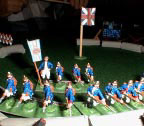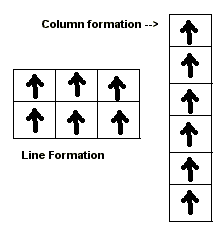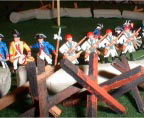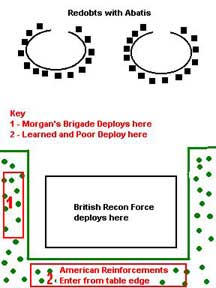
Turn Sequence
1. Americans Move
2. Americans Shoot
3. British Move
4. British Shoot
5. Charges
6. Melees
Formations
There are only two formations - line and column. The names of these formations can be very confusing for the students. At school, when they are told to "get in line" they line up one behind the other, in what we call column formation. With the kids I call the formations "firing line" (like a firing squad), and "marching column." Lines may be single or double rank, and may bend. Columns are single company. The British light infantry and Virginia Rifles may deploy in line with up to one stand width between stands. Inside the redoubts there are no formations, bases can move individually. Units may change formation at the start or end of their movement, but can only change formation once per turn.
 Movement
Movement
Infantry can move 6" if they are in line formation or 12" if they are in column formation. Commanders may move 12". Field cannons can move 6" but may not fire on a turn when it was moved. Redoubt cannons may not move, but all cannons can pivot in place during movement and still fire. Units may about face (turn 180 degrees) once per turn. Units may move backward while still facing to the front at half speed. Units cannot cross the abatis until cut a gap through it. Units may not move within 1" of an enemy unit except when charging.
Fire
Units that are in line formation and artillery that didn't move this turn may fire. Range is measured from the center of a unit to the nearest part of the target unit. Units may only fire to the front and may not fire through narrow gaps between friendly units, or over the heads of friendly units. Roll one die per base or two dice per gun model. The chart indicates the number needed for a hit. Remove one base for each hit rolled by the firing unit. It takes three hits in the same turn to remove an artillery base. Note that you only use the 1" firing column when shooting at a charging unit. If a unit is reduced to a single surviving base then the last base is immediately removed unless it is inside the redoubt.
| Shooting | 1" | 6" | 12" | 24" |
|---|---|---|---|---|
| Infantry | 5-6 | 6 | - | - |
| Virginia Rifles | 4-6 | 5-6 | 6 | - |
| Field Cannon | 4-6 | 5-6 | 6 | - |
| Redoubt Cannon | 4-6 | 5-6 | 6 | 6 |
Charges
Both sides may charge during the charge phase. A unit may not declare a charge unless it is in line formation and within 6" of an enemy unit. If it matters the Americans charge first. A player may measure to see if a unit is within charge range. One enemy unit must be chosen as the target of the charge. A unit that wishes to charge must first pass a morale check. If the unit fails moral nothing happens, it cannot charge this turn. If the unit passes its morale check then the target must pass a morale check. If the target fails it loses one base and immediately retreats 12", the charging unit is moved into the position vacated by the retreating target unit. If artillery is the target and it fails morale it is eliminated. If the target passes the morale check it has the option of firing at the chargers or counter charging. If the unit counter charges the two units meet in the middle and fight a melee. If the target decides to fire at the chargers it does so at a range of 1". If the charging unit survives the fire it moves into contact with the target and they fight a melee.
Morale Checks
If a unit has to take a morale check Roll one die and add any modifiers. If the roll is less than or equal to the number of bases (plus a commander if one is present), then it has passed. If the role is greater then it fails. Butler's Rangers, Indians, and Artillery must roll a 4 or less to pass a morale check.
Morale Die Roll Modifiers
Militia +1
Grenadiers, Lights, Morgan's Brigade -1
Melee
If a charging unit contacts an enemy unit there will be a melee. Each side rolls a die and applies the modifiers. High roll wins. The loser removes a stand and retreats 12". He must spend the next turn reforming. If the roll is a tie each side removes a stand and rolls again.
Melee Die Roll Modifiers
More stands than opponent +1
Hitting the flank or rear +1
Commander leading charge +1
Militia unit or artillery crew -1
Defending redoubt wall +2
Grenadier +1
Commanders
A Commander may join or leave one of his units during movement. This unit gets a +1 bonus on all melee rolls and the officer counts as a base when testing morale. Every time a unit with an attached commander is completely eliminated by enemy fire (last base removed), or is engaged in a melee (win or lose) roll one die. If the roll is a 6 the commander is a casualty and is removed from play. This is the only way a commander can be eliminated.
 Attacking the redoubt
Attacking the redoubt
To attack the walls of the redoubt the abatis must be cleared first. A unit must spend one turn in contact with the abatis to clear it. The unit must not move during the turn that it is clearing the abatis, and it must pass any morale checks caused by enemy fire. No unit may cross the abatis on the turn it is being cleared. Once the abatis is clear attackers may charge units defending the wall. The walls will protect the defenders from enemy fire. If a unit defending the wall is hit by enemy fire roll 1D6 for each hit. If the roll is a 1-4 then there is not effect, if the roll is 5-6 the hit counts.

Arnold's Finest Hour Battle of Saratoga 1777
- Historical Background and Set Up
Fast Play Rules for Students
Paper Soldiers and Saratoga (very slow: 369K)
Back to Table of Contents -- Junior General Report # 4
Back to Junior General Report List of Issues
Back to MagWeb.com Magazine List
© Copyright 2004 by Matt Fritz.
This article appears in MagWeb.com (Magazine Web) on the Internet World Wide Web. Other articles covering military history and related topics are available at http://www.magweb.com